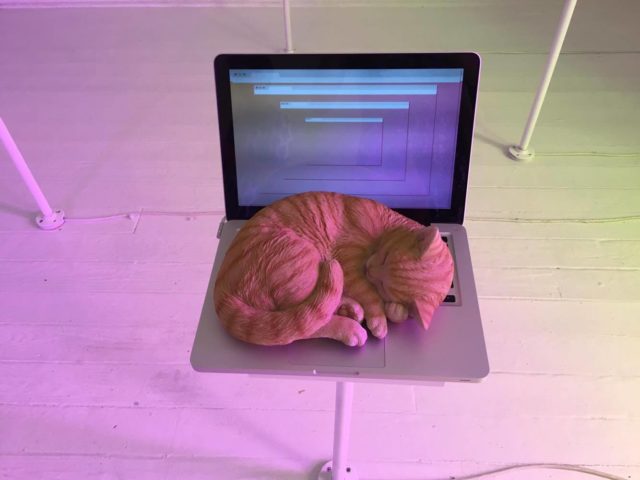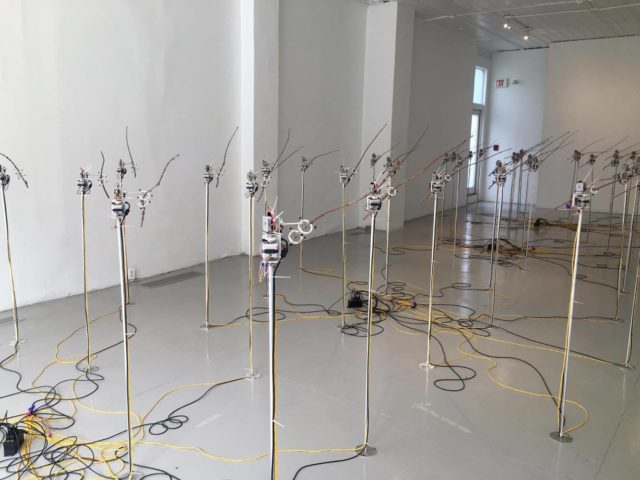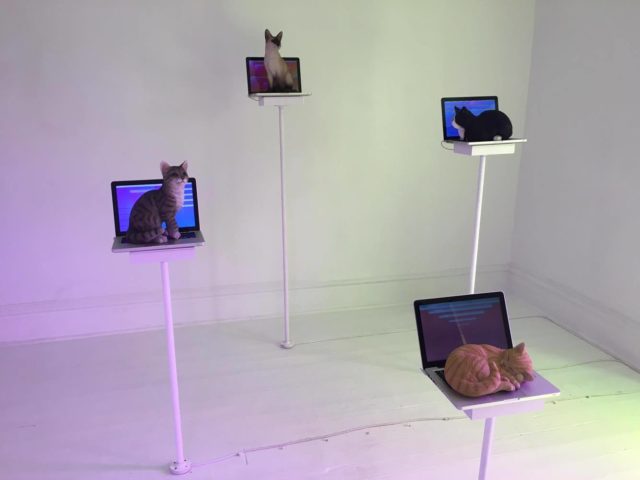
Detail from Kevin Clancy’s installation IRIS_SIRI at the Mattress Factory’s Factory Installed (all photos by author for Art F City)
Factory Installed
Mattress Factory
1414 Monterey Street, Pittsburgh, PA
Open until February 12, 2017
Artists: David Bowen, Kevin Clancy, Wendy Judge and Lauren Kalman
PITTSBURGH–What do you get when a curatorial vision is so generic, there’s almost nothing for an artist to work with? The Mattress Factory rolled these dice with their current show Factory Installed and came out ahead. Or at least 50/50, which for a show with no organizational principle, is pretty good.
According to the exhibition’s website, the organization started with a selection of artists who “demonstrate a uniquely different approach to the creative process.” You can’t get more generic than that.
The first part of a two-part exhibition (the second will open at the museum’s main building on September 30), the show is difficult if not impossible to take in as a cohesive whole. Each artist was given a separate room. Much of the installations’ isolation can be attributed to the random and unmovable position of the permanent collection, which lies scattered around the various rooms of the townhouse. this architectural restriction even further emphasizes the need for a dynamic curatorial theme.

David Bowen’s Spacejunk
And yet, by fluke or chance, the most successful installations in the exhibition engage with a timely dialogue about disillusionment and unease with the broken promises of utopic technology and innovation. Take, for example, David Bowen’s installation Spacejunk, which consists of fifty delicate reed-like gadgets placed around the building’s large entryway. The sheer amount of objects and their precarious spacing leaves only a small walkway for viewers to traverse. Each motorized gadget includes a twig placed at the top, connected to a movable sensor that tracks the oldest piece of human-made space debris that is circling the Earth above the horizon.
If you stand long enough in the installation, the twigs revolve in unison to follow the trajectory of the debris. Not only uncanny visually, the twigs make a horrible racket when they twist and turn. With a deafening brittle sound, the objects present a stark juxtaposition between the natural materials of a stick and the man-made junk in space.
According to the wall text, this space debris consists of parts of spent rocket bodies, defunct satellites and tools from missions beginning in 1958. Discussions about our collective destruction of the environment are certainly nothing new. And yet, this trash surrounding us in space is almost incomprehensible in its invisibility. With Spacejunk, Bowen makes this outer-space pollution both visible and audible, revealing the damaging side of Space Race idealism and continued space travel.

Lauren Kalman’s But if the Crime is Beautiful (Strangers to the Garden)
Not all the installations in Factory Installed are as fresh and compelling as Spacejunk. Detroit-based artist Lauren Kalman’s leaf-strewn second floor installation But if the Crime is Beautiful (Strangers to the Garden) treads the well-worn territory of Modernist critique. Engaging with Adolf Loos’ 1910 lecture in which he describes ornament as the aesthetic of criminals and degenerates, Kalman covers iconic, white Modernist furniture with bronze kudzu leaves. Kudzu leaves are an invasive species and symbolize the overtaking of the purity and utopianism of Modernism.
The installation also features a series of photographs of people wearing shrouds of these bronze leaves that resemble a soundsuit by Nick Cave if he made bottomless fetish gear. With their lower halves exposed, the semi-nude figures–and Kalman’s installation as a whole– reclaim the typically white male-dominated and Eurocentric Modernist sensibility with the bodies and decorative elements it rejects as impure. But so what? An artistic argument against Modernism in 2016 just feels tired and anachronistic despite the decadent beauty of the installation itself.

Kevin Clancy’s IRIS_SIRI
In contrast to Kalman’s work, as well as Wendy Judge’s Mountain, an artist-made rock that was so boring and unexceptional it’s barely worth mentioning, the most socially relevant installation, and consequently most exciting, was Pittsburgh-based Kevin Clancy’s IRIS_SIRI. Clancy harnesses the viral power of cat memes, newsfeeds and game show cash cubes to investigate the vacuity of the Internet age. The Internet was supposed to make the world smaller, make connectivity easier and support global conversations. While it has accomplished all that, Clancy shows that it has also made it easier for empty escapism.
His installation features a droning soundtrack and colored gels that block the windows. This floods the townhouse room with a vibrantly colored and unnatural light. Referencing the guilty pleasures of digital culture, four laptop computers sit on varying levels with cat sculptures perched on their keyboards. The laptops’ screens project a dizzying Technicolor and almost seizure-inducing array of infinitely opening browser screens and pop-ups. The cat sculptures–much like actual cats–block access to the computer, rendering it useless.

This frustrating sense of impracticality and impossibility extends throughout the installation with his impenetrable cash cube, which cycles unattainable bills with a burst of air. Similarly, Clancy also displays a wall-mounted mechanical hand that plays with an iPad. Cast to the size of his own hand, his sculpture, at first, seems as if it’s looking at a Facebook feed. On closer inspection, all the text and images have been redacted, which makes the infinitely repetitive scrolling even more meaningless.
Walking through IRIS_SIRI, I became palpably conscious of my own compulsive interaction with my phone even as I viewed the installations in the Mattress Factory. The greatest artworks have the ability to make you think about your own behavior and its relation to the surrounding culture and Clancy’s work does just that. Lucky for the Mattress Factory’s curatorial gamble, the best installations expose, fight back and even, poke fun at the current state of our culture. Even more, they present viewers with a means to question their own relation to both these utopias and dystopias.


Comments on this entry are closed.